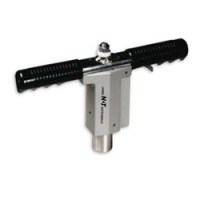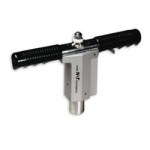Τηλεφωνικές παραγγελίες στο 210-6657343
Windsor Pin Test System - JAMES
A unique instrument for measuring the strength of new or existing construction materials in situ utilizing the established principle of resistance to penetration.
Windsor Pin Test System
A unique instrument for measuring the strength of new or existing construction materials in situ utilizing the established principle of resistance to penetration.
Measures the compressive strength of concrete, mortar and brick in-situ, quickly and accurately. A non-explosive instrument, the Windsor® Pin System uses a spring-loaded device to drive a steel pin into the concrete (or mortar). The depth of penetration of the needle correlates to the compressive strength of the material under test. A removable chuck and a small pin size facilitate the testing of mortar joints; this is the only system for testing the in-place strength of brick mortar joints.
Features & Benefits:
Portable and completely self-contained.
Safe to use - non explosive.
Economical - steel pin can be reused.
Non destructive.
Removable chuck facilitates testing of mortar strength in masonry.
Conforms to ASTM C-803
Test new concrete products and structures for early strength.
Evaluate the in situ strength in existing structures, e.g., after suspected fire damage.
Test strength of block, brick, and mortar joints within an existing structure, e.g., load bearing walls.
Test polymer concrete and patching compound.
Quality control of precast elements such as block, brick slabs and pipe.
Purchasing Notes:
Consumables: W-P Hardened Steel Pins for Windsor Pin System (sold separately, can be purchased per piece or per case of 40 pins.
Technical
The principle of the Windsor@ Pin system is that a spring drives a steel pin into the surface of the material. Since the depth of penetration is inversely proportional to compressive strength, the device provides a fast and safe way of determining the in situ strength of material.
The spring is loaded by tightening the retraction nut until the trigger mechanism latch closes to hold the spring in place. The stored potential energy is 91 lbs. in (108 NM). With the spring loaded it is compressed to a distance of 0.8 inches. Thus once the trigger is pulled there is enough force to test compressive strength of concrete to a maximum of 5300 PSI (36.9 MPA). The pin is made of a special high strength steel specifically designed for building material penetration and can be used about seven times. The Windsor Pin System comes with a go/no go gauge to test the pin(s) after each use. If the length is reduced sufficiently and the pin goes through the gauge, the pin(s) should be replaced. Not doing so will severely impact test results.
With the chuck on both the micrometer and the pin driver, flat surfaces can be easily and accurately measured. Simply make sure the chuck rests against the surface and pull the trigger. After the pin has penetrated the surface, clean the hole with the blower provided and measure depth of penetration. Compare this penetration depth to the previously prepared chart for the compressive strength of your material. Strength charts for typical mortar and concrete are provided with the unit.
The recommended practice is to take seven readings and discarding the two readings farthest from the mean. By doing this, the possibilities of accidently striking a flaw or near surface piece of hard aggregate, and using the resulting penetration to calculate strength; are sufficiently reduced. By grinding the test surface flat before testing, a more consistent result can be produced.
With the chuck removed, the pin driver is capable of accurately testing mortar joints. By inserting the V-barrel into the mortar joint, the pin will directly penetrate at the center of the joint. Then by following similar procedures as above, the compressive strength of the mortar joint can be accurately and safely tested. A similar V-shape on the micrometer facilitates measurement.
Calibration
The spring of this instrument has been selected for its ability to undergo many compression cycles with no loss of energy. However, it is recommended that the instrument be sent back to James Instruments (or an authorized distributor) for cleaning, recalibration, and replacement of the brass loading nut, at least once every year.
Frequently Asked Questions
Q. I have a concave mortar joint; can the Windsor Pin™ test it?
A. Yes, just remove the flat plate on the Driver Unit to expose the V-shaped tip. Don't forget to do the same with the depth gauge.
Q.How many tests do you get from each pin?
A.Depending on the strength of the material you might be testing you should get anywhere from three to five tests per pin.
Q.How accurate is the Windsor Pin™ System?
A.With the proper correlation testing, the Windsor Pin™ can get you within 10 percent of the actual in place strength. Just like most NDT tests you get your best results with a direct correlation of cores, cylinders, or prisms to match with the pin penetration.
Q. Can you over load the Driver Unit?
A. Yes, we recommend that you hold your hand over the trigger until you feel it click in. Remember to back screw off before you fire the unit.
Specifications
W-P-2000 Windsor Pin™ System
W-P-1040 Box of 40 pins with gauge for Windsor Pin™ system
Weight 18 lbs.(8.1 Kg)
Dimensions 17 x 12 x 6 inches (43 x 30 x 15 cm)
Instructions
Windsor Pin™ SYSTEM OPERATING PRINCIPLE
A spring-loaded device drives a steel pin into the surface of concrete or mortar and the depth of penetration is measured. Since the depth of penetration is inversely proportional to compressive strength, this system provides a fast and efficient way of determining the in situ strength of material.
The spring is loaded by tightening the loading nut until the trigger mechanism latch closes to hold the spring in place. The stored potential energy is 91 lbs. in (108 NM). With the spring loaded, it is compressed to a distance of 0.8 inches. Thus, once the trigger is pulled there is enough force to test the compressive strength of concrete to a maximum of 5300 PSI (36.9 MPa).
The pin is made of a special high-strength steel specifically for building material penetration and can be used up to seven times. The pin should be replaced if the length is reduced sufficiently enough for it to pass through a go/no-go gage.
PIN PENETRATION RESISTANCE TEST PROCEDURE
Insert a new pin into the chuck.
Tighten the loading nut until the trigger mechanism latch closes to hold the spring in place.
It is very important to back off the loading nut completely to the top of the load screw before pulling trigger. Failure to do so will result in damage to the threads of both nut and spindle.
Place the instrument on a smooth flat surface of the material to be tested (2-3 square inches). If necessary use a grindstone to prepare the surface.
Place the instrument perpendicular to the test surface and pull the trigger. The instrument should be held firmly against the surface, particularly when testing vertical walls and ceilings.
With the chuck removed, the V-shaped barrel can be inserted directly into the mortar joint – ensuring pin penetration at its center.
Remove the instrument, then using the rubber bulb-type blower, clean out the small hole made in the material surface.
Place the micrometer over the hole, making sure that the reference surface of the micrometer is flat on the material (For measuring mortar joints, the micrometer utilizes a V-shaped barrel similar to the pin driver.)
Insert micrometer probe to the bottom of the hole using the knurled thimble on the head of the micrometer.
Read and note the micrometer reading. Remove chuck to expose V-Shaped barrel if measuring in a mortar joint.
After each strike, check the steel pin in the go/no-go gauge provided - located in the plastic box containing 40 steel pins. If the pin can easily pass through the slot in the gauge, or it appears too blunt, it should be discarded and a new one selected. (Note: When checking the length of a used pin, make sure that it is parallel to the surface of the gauge.)
Repeat the above procedure seven times and reject the two readings farthest from the mean.
Average the five best remaining point readings and, using the charts provided, look up the corresponding compressive strength. If the pin is too blunt or too short, the strength of the material can be considerably overstated.


